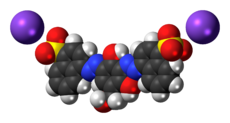Brown HT

|

|
| Names
|
| IUPAC name
Disodium 4-[(2E)-2-[(5Z)-3-(hydroxymethyl)-2,6-dioxo-5-[(4-sulfonatonaphthalen-1-yl)hydrazinylidene]-1-cyclohex-3-enylidene]hydrazinyl]naphthalene-1-sulfonate
|
Other names
- Chocolate Brown HT
- Food Brown 3
- C.I. 20285, E155
|
| Identifiers
|
|
|
|
|
|
|
| ChEMBL
|
|
| ChemSpider
|
|
| ECHA InfoCard
|
100.022.659 
|
| E number
|
E155 (colours)
|
|
|
|
| UNII
|
|
|
|
|
InChI=1/C27H20N4O9S2.2Na/c32-14-15-13-22(30-28-20-9-11-23(41(35,36)37)18-7-3-1-5-16(18)20)27(34)25(26(15)33)31-29-21-10-12-24(42(38,39)40)19-8-4-2-6-17(19)21;;/h1-13,32-34H,14H2,(H,35,36,37)(H,38,39,40);;/q;2*+1/p-2 Key: BIRIBMFCDVVRKL-NUQVWONBAS
|
[Na+].[Na+].Oc3c(cc(CO)c(O)c3N=Nc2ccc(c1ccccc12)S([O-])(=O)=O)N=Nc5ccc(c4ccccc45)S([O-])(=O)=O
|
| Properties
|
|
|
C27H18N4Na2O9S2
|
| Molar mass
|
652.56 g/mol
|
Except where otherwise noted, data are given for materials in their standard state (at 25 °C [77 °F], 100 kPa). |
Chemical compound
Brown HT, also called Chocolate Brown HT, Food Brown 3, and C.I. 20285, is a brown synthetic coal tar diazo dye.
When used as a food dye, its E number is E155. It is used to substitute cocoa or caramel as a colorant. It is used mainly in chocolate cakes, but can also be found in desserts, cookies, candy, cheeses, teas, yogurts, jams, chocolate drinks, ice creams, fruit products, fish, wafers, breakfast cereals, and other products.[1][2]
It is approved for use by the European Union.[3] It is banned in Australia, Austria, Belgium, Denmark, France, Germany, Norway, Sweden, Switzerland, Russia and the United States.[4]
References